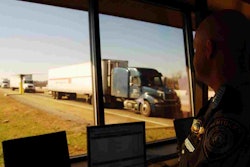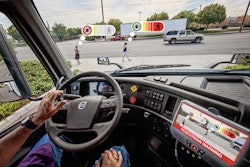Choosing an axle configuration used to be as simple as determining how many wheels you wanted on the ground and whether or not you wanted power to all of them.
Today, there’s a myriad of options available that blend some of the best parts of a traditional 6X2 or 6X4 into something entirely new.
Designed for segments with a high payload diversity, Volvo’s Adaptive Loading Axle uses an electronic control module and a hydraulic actuation system to create a fully automatic drive axle capable of adjusting weight and downforce as the unit’s load changes, providing maximum traction and fuel economy without input from the driver.
“98 percent of the time, the system will take care of itself especially when it comes to lifting and lowering the axle for the payload support,” Chris Stadler, Volvo Trucks North America product marketing manager for regional haul applications, said.
When the truck is loaded, the system uses pressure input from the suspension to balance weight between the two axles.
As the load lightens, more weight is automatically shifted onto the drive axle. Once the truck is empty, the non-drive front axle automatically lifts off the road and tucks out of the way, allowing the truck to operate in a 4×2 configuration.
The driver also has the ability to raise and lower the axle, and balance the payload, as conditions dictate.
“We have a traction mode where [the driver] can force the axle down to protect the chassis if they were at a dock getting loaded up,” Stadler says. “Or if they’re going down the road with a payload and both axles are down and the weather conditions change – maybe in the wintertime in a snowstorm – and they need some additional traction support, they can actually put it in Enhanced Traction mode and load up the drive axle to put extra pressure down to give them extra traction support. Similar to your difflock but not to that extreme and they can actually operate at a higher speed as well.”
As technology continues to plod along, electrification has become a more appealing and realistic option.
Hyliion‘s 6x4HE kind of converts a 6×2 configuration into a ultra-fuel efficient 6×4 with its electrically powered axle.
Hyliion founder and CEO Thomas Healy says the hybrid system can deliver upwards of 15 percent in fuel savings across hilly terrain, which is where the system was engineered to do its best work by providing a boost of supplemental power when engine loads are high.
Requiring no solar panels or plug-ins, descent down a hill allows a regenerative brake to pump charge back into the batteries.
The 6X4HE acts automatically, using sophisticated learning algorithms to maximize fuel economy.
For segments ready to go all-in on electric power, options on the heavy-duty side are few. Lighter commercial vehicle segments are leading this innovation.
Over the years, declines in the cost of batteries have made electrified solutions more viable. In turn, Harry Trost, senior manager of product planning for Dana Commercial Vehicle, said Dana has focused much of its early development work on lighter commercial applications that require fewer and smaller batteries to “manage the cost of an electric vehicle as the market was developing.”
Dana’s first production e-axle, the Spicer Electrified eS5700r e-Axle, entered production in April 2018 for China. It is an integrated motor and axle power system designed for Class 3 medium-duty van, truck and bus applications.
Trost called the integration of the motors and inverters “the next wave of the electric drive axle.”
The Spicer Electrified eS9000R leverages the architecture of the Dana single-reduction S110 and S130 drive axles already on the market but integrates the motor, transmission and axle power system. It is designed for Class 4, 5, and 6 vehicle applications.
“It has higher power capability [than the eS5700r]. It goes up to 237 kW peak power and it is also intended for higher voltage ranges,” Trost said.
Since many Class 4/5 trucks don’t feature pneumatic brakes, an electronic parking mechanism is also integrated.













